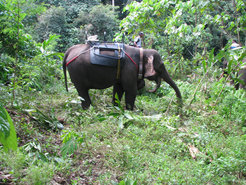Animals' early warning system
First the Earth shook, then came the flood: the underwater earthquake that occurred off the coast of Sumatra on 26 December 2004 was not just the third-strongest quake ever recorded, it also unleashed a powerful tsunami. Waves several metres high around the Indian Ocean claimed the lives of hundreds of thousands of people.

Today, a tsunami early warning system, consisting of thousands of measurement stations, is designed to warn inhabitants living in areas at risk of such disasters. The Indian Ocean Tsunami Warning and Mitigation System (IOTWS) registers underwater earthquakes in the Indian Ocean and rapidly informs people living between Indonesia and the Arabian Peninsula if it detects that a tsunami is imminent. A network of measurement stations in the ocean and buoys connected by satellite registers tremors and fluctuations in sea levels. However, the warning system is not just extremely complex from a technical perspective; it also swallows up a huge amount of money: each year, the system costs countries bordering the Indian Ocean between 50 and 100 million dollars.
An international team of scientists, headed by Martin Wikelski from the Max Planck Institute of Animal Behavior in Konstanz, is currently working on a very different – and simpler – type of early warning system. It's called Icarus, an acronym that stands for International Cooperation for Animal Research Using Space.
Icarus is attempting to make the extraordinary sensory abilities of many animals – their proverbial “seventh sense” – available to humans. Historical records show that even earlier cultures benefited from the knowledge of animals and aligned their activities accordingly. Moreover, there are many reports and stories of animals predicting disasters: restless birds before a volcanic eruption; snakes that awaken from hibernation prior to an earthquake; common toads who disappear and flee their colony in the middle of spawning season in advance of a major earthquake.

“When animals go crazy, run away from the sea and go to the highlands” advises a song sung by Indonesian children for centuries. In fact, people in Indonesia reported that elephants fled the coast for the interior of the country before the tsunami hit. However, in our modern, technology-based society, these animal skills have lost their importance and this warning signal went unheeded.
But do such eyewitness reports stand up to closer scrutiny? This question cannot be answered without technological assistance, as the unusual activities of animals, which in most of the reports indicate an impending disaster, can only be proven scientifically with great effort.
By now, scientists working with Martin Wikelski have conducted several scientific studies in this regard. For example, they attached sensors to cows, sheep and dogs in an earthquake-prone area in Northern Italy and recorded their movements over several months. The movement data show that the animals were unusually restless in the hours before the earthquakes. The closer the animals were to the epicentre of the impending quake, the earlier they started behaving unusually.

The researchers also attached transmitters to goats living around Mount Etna, recorded the animals' movements over several years and retrospectively compared the animals' movement profiles with volcanic activity. Their big moment arrived on 4 January 2012: at 10:20 p.m., Mount Etna began to spew large amounts of lava and ash into the air – six hours after the researchers had recorded unusual activity among the goats. Over the course of the study, which lasted two years, scientists were able to retrospectively “predict” a total of seven major eruptions based on their data.
Researchers also analysed the behaviour of common toads near the Italian city of L’Aquila, which in April 2009 was the scene of a major earthquake. The analyses show that the amphibians were already behaving unusually five days before the earthquake and had ceased their spawning activity.
Evidence is mounting, therefore, that animals perceive impending disasters earlier than humans with their measuring equipment. They then communicate this information through their behaviour – a type of animal early warning system for natural disasters. The knowledge that animals have could save thousands of human lives: for every extra minute of advance warning time, more people can be brought to safety, buildings at risk of collapse can be cleared and dangerous areas can be evacuated. Such information would also be incredibly valuable for insurance companies and could help to limit damages.

The available data is still too incomplete for such a warning system: more catastrophic events, more individuals, more species must be analysed to find out which animals respond to which events and how reliable they are in their response. Icarus's role is to create the conditions for such an animal early warning system. The vast amount of information recorded by the modern mini-transmitters will tell us whether animal sensors are suitable elements of an early warning system and if so, which ones. With a more reliable prediction of earthquakes, volcanic eruptions or hurricanes, Icarus could finally once again use the knowledge of animals to benefit us humans.



